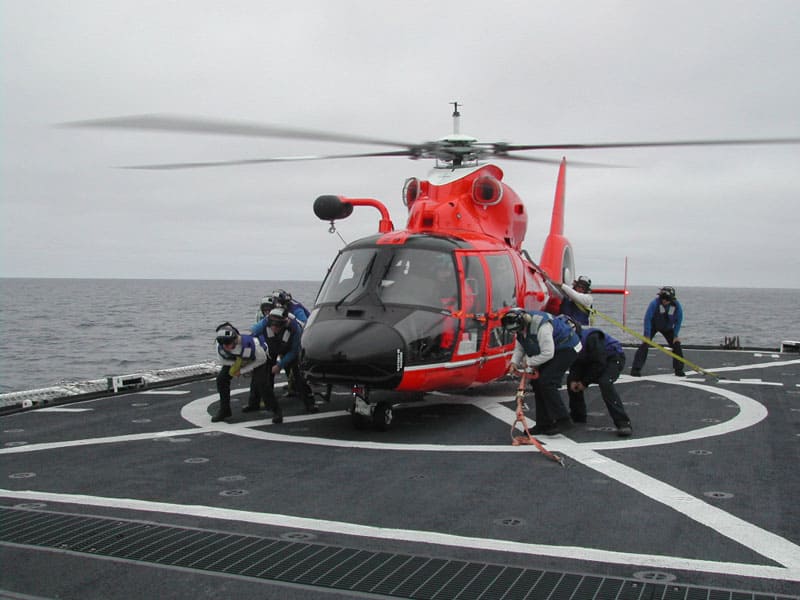HH-65C Shipboard Operations
Group-Air Station Atlantic City became operational 18 May, 1998. The Air Station is located at the William J. Hughes Federal Aviation Administration Technical Center at the Atlantic City International Airport, New Jersey. The establishment of Group-Air Station Atlantic City was the result of a Coast Guard aviation streamlining initiative to realign unit location with the capabilities of today’s modern aircraft. Air Station Brooklyn, New York and Group-Air Station Cape May, New Jersey resources were combined at the newly constructed $13 million facility.
The L-shaped floor plan was designed with the air station’s operations and maintenance control centers centrally located between the ready hangar and maintenance hangar for convenient access to each. A space-saving feature of Air Station Atlantic City was the hangar doors. Three collapsible doors enclose each of the hangars’ 142-foot openings. Most of your traditional hangars have huge sliding doors that take up a lot of the square footage of the building. With this facility, the door is stored overhead and out of the way. The hangar door supports swing up and you end up with a wide-open hangar bay. Included in the hangar construction is a 2-ton overhead crane rail on the maintenance side used for servicing helicopters and four, 2,000-gallon Aqueous Film-Forming Foam tanks with the capacity to douse both hangars twice in the event of a fire.
In 2005 with the transformation of Coast Guard Groups into the present day Sector shore command structure, the Group left Atlantic City and moved to Philadelphia leaving a standalone Air Station.
The Air Station is comprised of 10 HH-65C Dolphin Helicopters. Several tenant commands also have components located at the Air Station, including Sector Field Office and Electronics Systems Support Detachment Atlantic City. The Air Station supports the wide range of Coast Guard operations, such as search and rescue, law enforcement, marine environmental protection and port security for both District One and District Five, encompassing the coastlines of Connecticut, New York, New Jersey, Pennsylvania, Delaware, Maryland and Virginia including interior bays and rivers such as the Chesapeake, Delaware, Hudson and Long Island Sound. One of Air Station’s HH-65s maintained a Coast Guard presence in the Brooklyn area, operating out of Air Facility Long Island, N.Y., at the Frances S. Gabreski Airport.
Air Station Atlantic City maintains two Dolphin helicopters in 30-minute response status. Both can be quickly airborne and enroute at speeds in excess of 145 knots. The HH-65C Dolphin typically carries a crew of four, consisting of two Pilots, one Flight Mechanic and one Rescue Swimmer. The Rescue Swimmer is a certified Emergency Medical Technician (EMT) who can be lowered out of the helicopter to assist personnel in distress. The Dolphin can also deliver dewatering pumps to sinking vessels, hoist victims from the sea with its rescue basket, and can “medevac” injured persons with a rescue litter for delivery to local hospitals.
In 2006 Air Station Atlantic City took on the responsibility of protecting the airspace surrounding the nation’s capital. Utilizing a concept termed Rotary Wing Air Intercept, the Coast Guard assumed the duties of intercepting low and slow aircraft penetrating the highly protected airspace surrounding Washington, DC. Aircrews from Atlantic City and supporting air stations stand ready to be launched for any aircraft that may be deemed a potential threat.
The Air Station was assigned responsibility for field testing new upgrades for the HH-65 helicopter. In 2008 the upgraded MH-65C airframes were received. In addition to the more powerful engine the aircraft has provisions for weapons to enable the airborne use of force; infrared and electro-optical sensors; head’s up night vision displays and other improvements. Fielded first at HITRON Jacksonville in the armed helicopter counter-drug enforcement role, the MH-65C’s first multi-mission implementation took place at Atlantic City.


